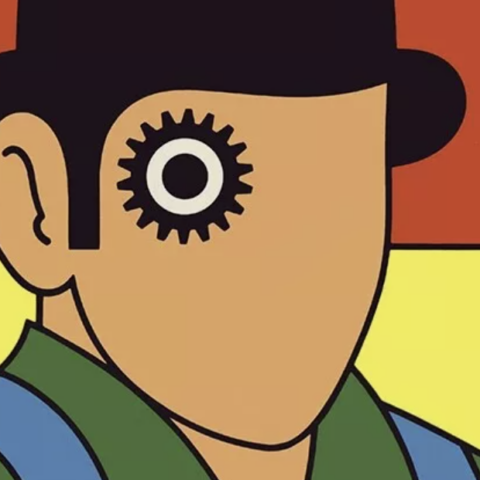Frame; Fiction and the Digital Age
By Jo Phillips
Being written in the latter stages of the 19th Century, Oscar Wilde’s The Picture of Dorian Gray was created in a pre-digital age, set in a pre-digital age. This is obvious. But what this story does do is revolve entirely around the mere idea of one single frame, and this one single frame inspired a work of fiction so multifaceted and psychological that it went on to become one of the most important literary achievements of all time.
We all know that the 20th Century was revolutionary in the arrival of the digital age. Technology expanded at an unprecedented pace, expanding and changing the connotations of the word ‘frame’. Cameras now fit in our pockets, ready to capture and share. Footage glances by the crowd and the lens flares as it catches the blinding light reflected in a skyscraper building. A billboard ad with a photo of a model that you’re sure you recognise. Crowds panic for a reason you’re not quite sure of at first. Your partner doesn’t like it; they turn over before you can find out. On the next channel is a mind-numbing reality TV programme.
Today, we (especially millennials- sorry to say that word) are exposed to disparate media outlets, the effects of which we are, on the whole, uncertain about.
Like all phenomenon, the event of the digital age was bound to influence contemporary writers, and not only influence them, but elicit a response. So can you think of an example of literature that centres around a digital image? Here are some of Cent’s most captivating and terrifying examples.
Don DeLillo
One of the major themes of Don DeLillo’s work is media consumption and debilitating entertainments. He is mostly known for novels such as Underworld and White Noise, but his short story VideoTape is a great little one to start us off. This easy-read short draws you into a man repeatedly watching some frightful news footage. He rewinds, replays the images. Behind the camera is just a little girl; the camera is a toy to her as she playfully films a stranger in the car behind her. It explores a man’s desensitisation to a violent act, captured entirely by coincidence. If you think you might be interested in DeLillo’s work but don’t know where to start, VideoTape is probably the answer.
Flicker
Author Theodore Roszack is an academic generally credited with creating the notion of ‘counterculture’, though his fictional work proves to be spellbinding. Flicker involves the research of a film scholar, who gradually finds himself sucked into an obscure conspiracy that underlies the work of a fictional B-movie director. Real-life director Aronofsky (Pi, Requiem of a Dream, Mother!) has been associated with a possible film adaptation.
Throat Sprockets
The next suggestion concerns an unnamed protagonist’s relentless hunt for information about an enigmatic porn film called Throat Sprockets. The man’s obsession consumes his personal life as he develops a sexual fetish for women’s throats. Repercussions of the film’s growing status become catastrophic. It’s more than just a comment on toxic masculinity though- Tim Lucas’s novel is an unputdownable erotic horror.
Snuff
Sticking with the pornography theme (for now at least- don’t worry, not all of our suggestions are porn-orientated!) our next recommendation is Snuff by Chuck Palahniuk. You may have heard Palahniuk’s name for another reason, but… the first rule of Fight Club is you don’t talk about Fight Club.
Actually, very quickly, remember that bit in Fight Club when Tyler Durden has a job in film editing, and he sneaks one frame of a porn film into a family movie?
Anyway- Palahniuk’s Snuff is a social-sexual satire with a few points of view. Chapters vary from the internal monologues of Mr. 600, Mr. 72, and Mr. 137, all men waiting their turn to bed pornstar Cassie Wright. They will star in a film that will break records in porn history. Snuff delves into the rarely acknowledged presence of pornography in contemporary U.S.A.
The Falling Man
This time, a piece of fiction based on a real image, and one you may be familiar with, it’s Don DeLillo’s The Falling Man. Set shortly after 9/11, the book follows Keith, a lawyer who worked in the World Trade Centre. Keith’s reflection on the surreal events of that day are intricately described by DeLillo, a subject not many writers would dare tackle. That’s not strictly true actually, as there have been many attempts at 9/11 fictional stories, to the point where some preposterous on-screen works (e.g. Nicolas Cage is a firefighter in 2006’s ‘World Trade Centre’, last year’s thriller just called ‘9/11’ starring Charlie Sheen) have almost become their own little tedious accident of a franchise. To say not many writers could achieve what DeLillo does and pull off the subject matter would be more suitable. The image here? Well, that’s the experience of Keith’s estranged wife, who consistently witnesses a performance artist around the city. He is dubbed the “Falling Man”, wears business attire, and suspends himself upside-down with rope and a harness in the pose of the man in the famous photograph of the same name by Richard Drew.
ZeroVille
The concept of Steve Erickson’s ZeroVille will put it at the top of your read-list. An inspired young architecture student, Jerome, a character with a few autistic tendencies, travels to Hollywood and uncannily discovers a secret film, found frame by frame in every movie that’s ever existed.
Fresh off the back of the success of The Disaster Artist, James Franco is directing an adaptation of Erickson’s novel, with a film of the same name being released this year. It seems Franco is doing everything at the moment though and even has the rights to a Bukowski adaptation.
Infinite Jest
Remember Throat Sprockets? Don’t worry, no, we’re not back to the porn theme. However, David Foster Wallace’s Infinite Jest is not dissimilar to Throat Sprockets in terms of characters searching for an enigmatic film. Set in near-future Boston, the encyclopedic novel centres around the boys at a Tennis academy and the inhabitants of a drug rehabilitation centre, amongst several other narratives. These stories intertwine and connect through a film which is the source of all ecstasy, to the point where anyone who views Infinite Jest cannot look away from it. As with all of DFW’s work, it’s a mind-bending novel. It’s also one hell of a document. It’s is a mix of easy-to-read and very difficult-to-read, but there are undoubtedly huge stretches of brilliance.






![[Un]Natural: 3 Artworks We’re Revisiting This Month](https://centmagazine.co.uk/wp-content/uploads/2017/04/The-Plague-arcola_opt-1.jpg)


